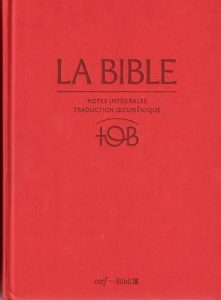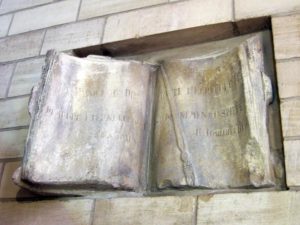A big library
Etymologically the word Bible comes from the Greek “ta biblia” which means the books. Indeed, the Bible is a collection of many different books, written by a wide range of authors and at different historical periods. It contains a variety of literary genres : narratives, legislative texts, epics, poems, prophetic oracles, words of wisdom, letters, the Gospels, the Book of Revelation etc. In order to understand how they were written much historical and archaeological research has been carried out. Some narratives were passed on orally from one generation to another, other texts were re-written or invented by the author ; material was obtained from different oral and written sources. But their specificity lies in the fact that they deal with the reality of personal and collective humanity from the perspective of the author’s relationship with God ; in the Bible one seeks God, his presence is acknowledged or his absence criticised.
The Bible as the foundation of faith
For Jews and Christians alike, the Bible is the very foundation of their faith because it enables them to discover God’s word, either individually or collectively, during religious services. There have been many Bible commentaries and the texts still form the basis of study and discussion.
While the Christians consider the whole Bible to be important, for the Jews it is the first five books (called the Torah) which are essential to their faith. It is worth noting that the written Torah cannot be dissociated from the oral Torah, which has several different traditional interpretations.
Several different Bibles
Most of the books to be found in the Bible have been written over several centuries and existed separately before being gathered together into one collection, which was different for Jews and Christians (Protestant, Catholic or Orthodox).
Although the various Bibles have many texts in common, all Bibles are not the same – some have a specific selection of books and others are grouped together differently. This can be disconcerting at first. However, on the whole, the actual contents of the texts are very similar.
The Hebrew Bible
The Jewish authorities have only kept the texts which were written in Hebrew – these make up the Hebrew Bible. It was actually at the end of the first century, after the destruction of Jerusalem in A.D.70, that the Jewish authorities decided to make a clear distinction between their own Scriptures and those written in Greek by the Jews of the Diaspora or the texts of the early Christians. This led to the establishment the canon of the Hebrew Bible, although the exactly how is still disputed by historians.
The Septuagint
From the 3rd century B.C. onwards, the Alexandrian Jews began to translate their Scriptures into Greek, that is to say, into the language which they spoke every day. They also added extra texts, later called the “deuterocanonical” or the apocryphal” books. This collection, called the Septuagint, (as legend would have it, this translation of the Bible from Hebrew into Greek was undertaken by 70 or72 scholars) differs from the Hebrew Bible in the number of books it contains, the way in which these have been ordered and of course, the language in which it was written. The organisation of the books in the Septuagint was probably done by Christians who used the Septuagint throughout the first centuries of the Church. This Bible isstill used today by Christians in the East.
Christian Bibles
Jews and Christians did indeed share the same books during the early centuries A.D. However, before the end of 100 A.D., the Christians had built up a collection of texts in Greek, which they added to the others : there were first hand accounts of the life of Jesus Christ (the Gospels) as well as writings and letters giving an account of the life and faith of the early Christian communities. They are the fruit of a re-reading of Jewish Scriptures in the light of the Christian faith. In this Christian Bible, established by canon in the 4th century A.D., there are two parts : the Old Testament consisting of the texts from the Hebrew Bible and the Septuagint and the New Testament, comprising texts dealing with the Christian faith (the Gospels, letters and other Christian documents).
The Deuterocanonical or Apocryphal books
Most of the Old Testament is common to both Jews and Christians, as the thirty-nine books of the Hebrew Bible are recognised by Christians as being canonical. Other books from the Septuagint are also recognized by the Orthodox and Roman Catholic Churches. Catholics recognise the following books as “deuterocanonical”, that is to say, belonging to a second canon : Judith, Tobit 1 and 2, Maccabees, the Book of Wisdom, Sirach, Baruch, Jeremy’s letter and the parts of Ester and Daniel which were written in Greek. The Orthodox also recognise the Septuagint and Greek parts of 3 Esdras, 3 and 4 Maccabees, the Prayer of Manassah and Psalm 151. Protestants consider these to be apocryphal, that is to say, secret or hidden in Greek and do not recognise them as canonical. However, until the 19th century all Christian Bibles, including those of the Protestant Church, contained these additional books.
Translations of the Bible
Today there are many different translations of the Bible, because since ancient times it has been translated into numerous languages. Some of these translations have been very important, for example, the Targums (a translation into Aramean), the Septuagint (a translation into Greek dating back to about 250 B.C.), the Vulgate (a translation into Latin by Saint Jerome between 342 and420 A.D. which was the reference for Christian Churches over several centuries), and also the Peschitta (a translation into Syriac dating back to the 5th century A.D.).
In the 16th century, the Christian Bible was translated on a large scale into the everyday European languages of the time. From the 19th century onwards, the development of Christian missions overseas led to new translations of the Bible into many non-European languages mostly by the emerging Bible Societies. At the same time, existing translations were also improved.














